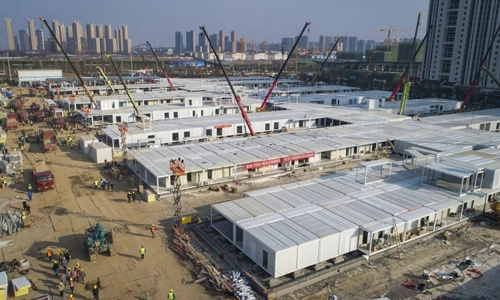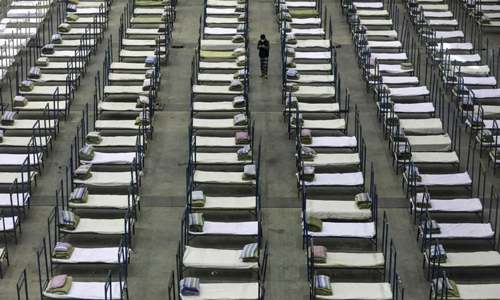Every field hospital has sprung up as evidence of Chinese authorities' efforts to fight pneumonia.
In Phuc Thanh, Fujian, on a recent afternoon, workers replaced a small sign that read "Fever Clinic" with a larger one. The people around the attentions adore the ornamental plants in front of the house to create accents.

Construction site of Lei Shen Son field hospital in Wuhan on February 4 Photo: AP
This is a newly established facility for treating Covid-19 infected patients in Phuc Thanh. That day, a delegation of government officials and journalists and reporters from state news agencies will visit the clinic. For Chinese officials, building a 200-bed treatment center in a few days is not enough, but they still need to promote this.
Across China, from the Wuhan epidemic center to Harbin in the north, Shenzhen in the south, Chengdu in the west or Wenzhou in the east, medical facilities built with lightning speed are constantly springing up. to provide treatment for nearly 60,000 nCoV virus infections.
Authorities have turned stadiums and gyms around Wuhan into temporary quarantine areas and sent thousands of military medical doctors to support them. According to observers, the purpose of establishing isolation facilities is clearly to prevent the virus from spreading. But on the other hand, there is also a political motive behind them. Party leaders in Beijing need it for the public, who is increasingly bewildered, angry at the uncontrolled disease, to see that they are still actively taking action.
"The central government is working hard to make their reactions visible," said Taisu Zhang, a professor at Yale Law School, an expert on contemporary Chinese politics.
Two field hospitals were set up in Wuhan in more than two weeks with 2,600 beds serving as evidence of the government's determination to fight Covid-19. The process of building two hospitals was also broadcast live 24/24 and received countless compliments on the state television channels.
The People's Daily newspaper, the mouthpiece of the Chinese Communist Party, called Mars Shanshan, the first field hospital built in Wuhan, as a "miracle". Dozens of other hospitals are continuing to be built from scratch or renovated from existing health facilities.
In Fujian Province, sandwiched between the most severely endemic areas outside of Hubei province, two Covid-19 treatment facilities have just been completed, one in Phuc Thanh and one in Phu Dien.
By the time the Washington Post visited, the facility in Phuc Dien was under construction, but workers said it would be completed in a few days.

Inside an isolated treatment area converted from a convention center in Wuhan on February 4 Photo: AP
In recent days, the Phuc Thanh facility is going into the final stage, preparing to hand over. Electricity and water systems are ready to connect, cameras are installed.
Eric Toner, an epidemiologist at Johns Hopkins Health Security Center, said the pace of China's construction of health facilities was impressive, but they could not be called "hospitals."
"They are more like assessment and treatment centers for people suspected of being infected with the nCov virus," he said. "It seems that only really seriously ill people are sent to standard hospitals."
According to observers, with Chinese President Xi Jinping and his officials, how to show that they are actively taking action is also an extremely important task.
"This pandemic is something that everyone can see and affect the well-being of everyone," said Professor Zhang.
The crisis has caused the Chinese health industry to buck down and cause such economic damage that some experts say it could have more devastating effects than the trade war with the United States. .
In the face of rising domestic criticism of how the government responded to the crisis, especially after the death of ophthalmologist Ly Van Luong, the first to warn about the risk of disease outbreaks, the central government The central government tends to hold local officials accountable.
Local officials also occasionally protest. Wuhan Mayor Chu Tien Vuong was accused of not promptly disclosing information about the virus. "As a local official, after receiving this kind of information, I still had to wait for permission from the above to publish it," Zhou said last month on television, emphasizing that he was limited by the regulations of the apparatus.
The question now is whether the lessons of the Covid-19 outbreak will be enough to change the political system in China, which is increasingly concentrating power in the hands of President Xi, who leads. The country since located 2012, or not. It all depends on who the responsibility is.
Many commentators have questioned whether the death of Dr. Li Wenliang in Wuhan could be "a drop of a glass of water" in the context that the Chinese public has shown them to be extremely resentful after him. died. The feeling that the authorities don't act for the people makes the public angry.
But according to observers, if the Chinese government can control the disease quickly, it will become a stepping stone to help President Xi strengthen further power.
The central government also had a reason to justify the tough policies it enforced in recent years, said Dali Yang, a political scientist at the University of Chicago.
"In the name of 'protecting social stability', they have gathered information from people and increased surveillance activities. The technologies, equipment and activities that serve the purpose suddenly become more appropriate when an outbreak occurs, "Yang said, referring to modern Chinese surveillance technology through facial recognition cameras or mobile phones.
Chinese officials have been using these technologies to monitor people and find people from the epidemic area to take appropriate action, such as forcing them to quarantine.
"In fact, the message from China's top leaders now all around the rising risks of disease outbreaks, so that they can expand the concept of national security to include it all." everything, including medical, "Yang commented.
Countries with nCoV pneumonia patients. Click on image to see details.



 AbbyWeatherford
AbbyWeatherford







